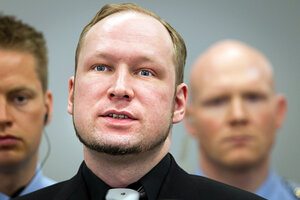Norway killer Breivik: Voices in my head told me 'Don't do this'
In the most emotional day yet during the trial of Anders Behring Breivik, who has claimed responsibility for the July 2011 terror attacks in Norway, the suspect gave a detailed account of the attacks.

Defendant Anders Behring Breivik in court at the start of the 5th day of his mass killing trial in Oslo, Norway, Friday, April 20. Confessed mass killer Breivik gave his most gruesome evidence yet Friday during testimony in the trial of the July 2011 terror attacks that left 77 people dead.
Heiko Junge/AP
Oslo
Norwegian mass killer Anders Behring Breivik gave his most gruesome evidence yet today during testimony in the trial of the July 2011 terror attacks that left 77 people dead.
After warning people to leave the courtroom because his testimony might distress them, Breivik explained in his fourth day of cross-examination how he arrived on the island of Utøya on July 22 and calmly and methodically executed Labor party youth members, many who stood paralyzed in fear as he shot them with a Glock pistol and Ruger semi-automatic rifle.
“I thought 'It’s now or never',” said a red-faced but composed Breivik, referring to his thoughts before taking his first victim. “A hundred voices in my head said, 'Don’t do this'.”
He said his intention was to kill not just the 69 who did die on the island that day, mostly from shooting, but all of the camp attendees by frightening them into fleeing into the water to drown. He said he didn’t understand why some “just stood there” and tried to scare them into attempting to swim away by shouting a “psychological cry” twice in the campsite area: “You shall die today, Marxists.”
He said he used a cellphone he found on the ground to call the police during the attack to surrender because he felt he had “achieved his objective," although he continued shooting after the call.
Breivik’s cold-blooded recount has been the most emotionally provocative moment so far in the trial for Norway’s worst peacetime atrocity. The Norwegian confessed to both the car bomb attack on government headquarters, which killed eight, and the shooting rampage at Utøya that took 69 lives, mostly teenagers. Victims’ families in court today cried and held on to each other as they listened in disbelief.
Breivik revealed during cross-examination earlier today that he almost called off his plans for the attacks. He said he lost faith in democracy after the Norwegian media censored their coverage of the Muslim riots in Sweden and France that year, just a few weeks ahead of Norway's general elections in September 2009.
He said he felt that the “Marxist” media feared that if they covered the events, the far-right Progress Party – an anti-immigration party of which he was a member – would have gained more votes, upending the Labor-led coalition government. Breivik has blamed his attacks on the Labor party for promoting multiculturalism and the "ethnic cleansing" of indigenous Norwegian with its immigration policies, which have allowed many Muslim immigrants into the country.
“If the media had given the Progress Party a fair chance without demonizing them before an election, then I wouldn’t have carried out the attacks,” Breivik told defense attorney Vibeke Hein Baera.
He added that he drove to Utøya after the bomb attack in Oslo only because he heard on Norwegian P4 radio that only one person was confirmed dead and the government’s main building had not collapsed as planned. His inspiration for that type of car bomb attack was taken from the Oklahoma City and 1993 World Trade Center bombings, he said.
“I knew the whole time that if the action has been 100 percent successful, that the building had collapsed and all employees had died, the action at Utøya would not have been necessary,” he said. “Then I would have driven straight to Grønland (police station) and surrendered.”
The defense spent the bulk of the morning establishing the sources for Breivik’s radicalization and how he had gained the knowledge to carry out such an attack. Breivik said he had found most of his information on the Internet, including Arabic literature on Al Qaeda, whose methods and media effect he had studied since 2006.
“I wanted to make a version of Al Qaeda for European Christians and nationalists,” Breivik told Geir Lippestad, his defense attorney, during cross-examination.
The comments follows yesterday’s shocking revelation that Breivik had originally planned to decapitate Gro Harlem Brundtland, Norway’s former Labor prime minister, at Utøya and film the event. He also said he sought to kill all on the island that day by using the water as a weapon of “mass destruction” by forcing them to swim and drown. Neither plan succeeded.
He also detailed a list of other potential targets for his original plan to use three car bombs, one at the government headquarters, which he did carry out, and two more at the Norwegian Royal Castle and Labor party headquarters.

